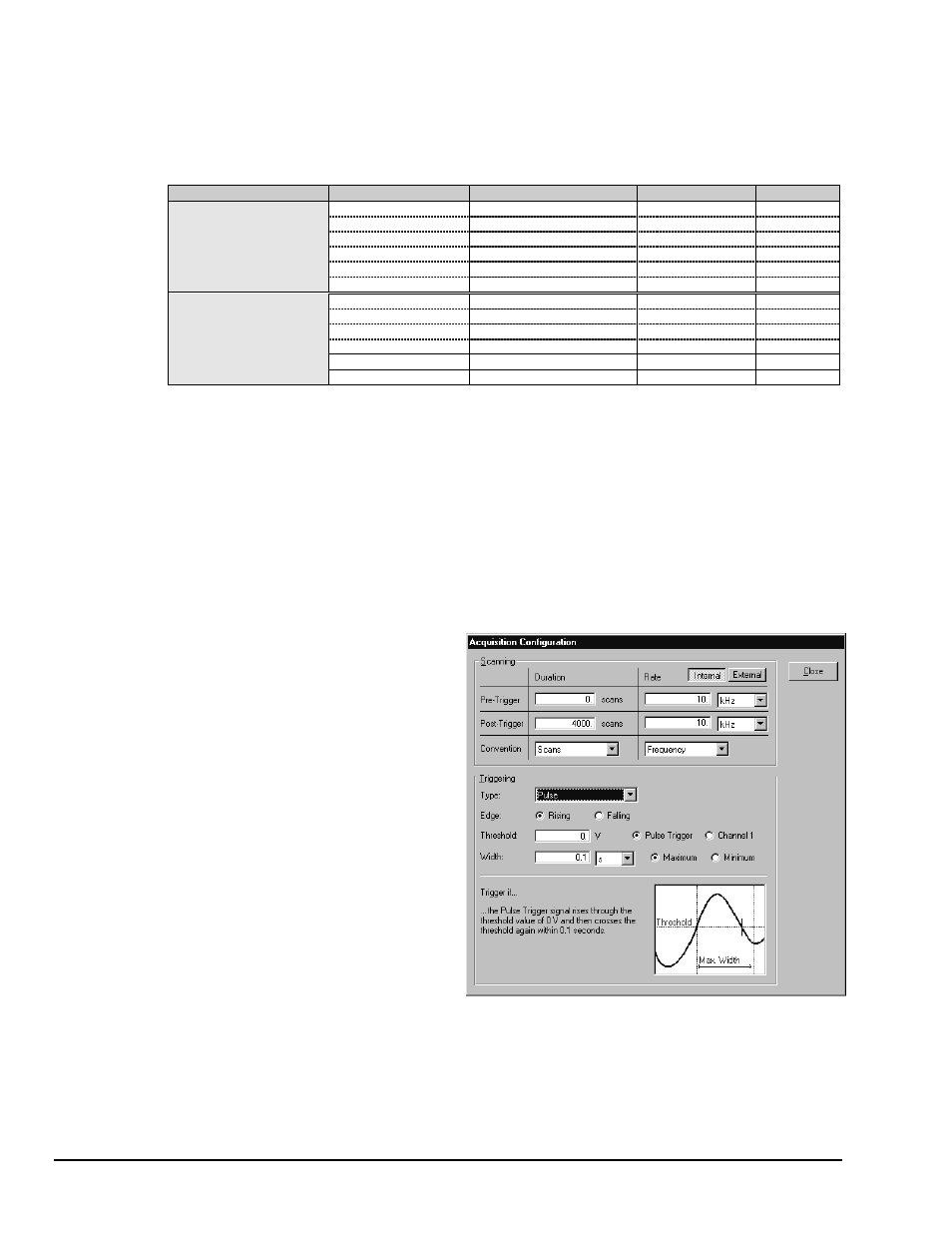Pulse trigger (wavebook/516 series only), Pulse trigger – Measurement Computing WaveBook rev.4.0 User Manual
Page 60

4-14 WaveBook Operation Reference
06-08-01
WaveBook User’s Manual
The time needed to complete the final pre-trigger scan is part of the trigger latency; and so, in the pre/post-
trigger mode, the trigger latency may be greatly increased.
Not only do the trigger latency and jitter depend on the pre- vs post-trigger type of acquisition, they also
depend on the trigger source: Software, digital (TTL), single-channel (Channel 1 analog), or multi-channel.
The following table gives the trigger latency and jitter for each of the different trigger sources and
acquisition modes:
Acquisition Type
Trigger Source
Max. Trigger Latency
Trigger Jitter
Notes
Software
100 µs + T
100 µs + T
a, c
Digital (TTL)
200 ns + T
50 ns + T
c
Single-Channel
300 ns + T
50 ns + T
c
Multi-Channel
2 * T - NS µs
T
c, d
Digital Pattern
300 ns + T
50 ns + T
e
Pre-Trigger
Pulse
300 ns + T
50 ns + T
e
Software
100 µs
100 µs
a
Digital (TTL)
200 ns
50 ns
Single-Channel
300 ns
50 ns
Multi-Channel
2 * NC + 3 µs
NC +2 µs
b
Digital Pattern
300 ns
50 ns
e
Post-Trigger (N-Shot,
N-Shot with re-arm, or
infinite-post-trigger)
Pulse
300 ns
50 ns
e
Notes: a) Software trigger latency and jitter depend greatly on the host computer's speed, operating system, and
printer-port protocol. Most systems should take much less than 100 µs.
b) NC is the number of channel samples used for multi-channel triggering, from 1 to 72, as specified by the trigger
configuration.
c) T is the pre-trigger scan period.
d) NS is the number of samples in a scan including, if present, the first "dummy" sample, from 1 to 128.
e) WaveBook/516 series only
Pulse Trigger
(WaveBook/516 Series Only)
In addition to the standard “single-channel” trigger-on-level functions, the WaveBook/516 system supports
pulse trigger. The connection is made via BNC connector located next to the Channel 8 BNC. With pulse
trigger, you can define both the amplitude and the duration of the pulse that will be used to trigger the
acquisition. Pulse trigger can be used to detect spurious transients that can be missed by simple level
triggers.
Pulse Trigger allows the use of a high-
bandwidth input for triggering, and the
correlation of lower-speed waveforms with
the occurrence of a high-speed pulse. You
can set a pulse amplitude between
±5 V and
a pulse width in the range of
100 ns and 800 ms.
Pulse Trigger Selected
This option allows you to trigger on analog level “pulses” on either the Channel 1 input or the Pulse Trigger
input. This trigger type is similar to the Channel 1 Analog trigger but places an additional time-based
condition on the signal. Depending on whether the pulse width is set as a minimum or a maximum, the
signal either must or must not cross the threshold again within the given amount of time.
